An Underactuated Universal Gripper: Design, Analysis, and Experiment
Abstract
:1. Introduction
2. Development of Underactuated Universal Gripper
2.1. Structural Design of Mobile Robot
2.2. Structure and Working Principle
- (1)
- The camera locates the target object, and the robotic arm drives the gripper to approach the target object.
- (2)
- According to the shape recognition results of the target object, the relative position and posture of the three fingers in the gripper are adjusted by the DC motor drive.
- (3)
- Driven by the DC motors, the crank train mechanisms drive the four-bar mechanisms to move, and the phalanx moves to the center and contacts the surface of the object.
- (4)
- The motor continues to drive until the gripper stably grabs the object. Finally, the object handling is achieved due to the movement of the robotic arm.
2.3. Gripper Parameter Setting
2.4. Control System Design
3. Performance Analysis of Gripper
3.1. Grasping Process
3.2. Kinematic Analysis
3.3. Static Analysis
4. Simulation and Experiment
4.1. Motion Simulation
4.2. Statics Simulation
4.3. Universal Gripping Test of Gripper
- (1)
- Time = 0–3 s, the mobile robot moved and located the target object by the camera.
- (2)
- Time = 3–9 s, we controlled the gripper motor action, and adjusted the gripper to the appropriate position and attitude to successfully grasp the target object.
- (3)
- Time = 12–24 s, the mobile robot reached the target area, and the target object was placed through cooperation between the camera, the robotic arm, and the gripper.
- (4)
- Time = 24–27 s, the robotic arm was reset, and the handling task was completed.
5. Conclusions
- (1)
- This new underactuated universal gripper integrated a crank train mechanism and a four-bar mechanism to achieve the grasp and release of objects accurately. Based on this, the structural design and control system design of this gripper were carried out.
- (2)
- In the kinematic analysis of the gripper, the spatial position of the distal phalanx of the gripper during movement was calculated; through ADMAS kinematics simulation, the changes in contact forces, joint angles, and joint torques under the two grasping modes of the gripper were revealed.
- (3)
- In the static analysis of the gripper, numerical calculation revealed the static balance conditions of the gripper in various grasping modes, and the deformation cloud and stress cloud of the gripper were obtained using ANSYS software.
- (4)
- A prototype of the proposed gripper was designed and manufactured based upon the simulation analysis, and the experimental results verified the effectiveness of the proposed gripper.
Author Contributions
Funding
Data Availability Statement
Conflicts of Interest
References
- Bartoš, M.; Bulej, V.; Bohušík, M.; Stanček, J.; Ivanov, V.; Macek, P. An Overview of Robot Applications in Automotive Industry. Transp. Res. Procedia 2021, 55, 837–844. [Google Scholar] [CrossRef]
- Yin, Z.; Li, Y. Overview of Robotic Grasp Detection from 2D to 3D. Cogn. Robot. 2022, 2, 73–82. [Google Scholar] [CrossRef]
- Yadav, A.; Prakash, A.; Kumar, A.; Roy, S. Design of Remote-Controlled Land Mine Detection Troops Safety Robot. Mater. Today Proc. 2022, 56, 274–277. [Google Scholar] [CrossRef]
- Chen, X.; Huang, H.; Liu, Y.; Li, J.; Liu, M. Robot for Automatic Waste Sorting on Construction Sites. Autom. Constr. 2022, 141, 104387. [Google Scholar] [CrossRef]
- Zhou, Y.; Luo, J.; Wang, M. Grasping Force Optimization for Dual-Arm Space Robot after Capturing Target Based on Task Compatibility. Adv. Space Res. 2022, 70, 1496–1511. [Google Scholar] [CrossRef]
- Patil, V.; Narnaware, T.; Gangwani, T.; Raykar, N.R. Development of Flexible Universal Gripper for Handling Light Weight Parts of Arbitrary Shape. Mater. Today Proc. 2020, 28, 2591–2598. [Google Scholar] [CrossRef]
- Zhang, B.; Xie, Y.; Zhou, J.; Wang, K.; Zhang, Z. State-of-the-Art Robotic Grippers, Grasping and Control Strategies, as Well as Their Applications in Agricultural Robots: A Review. Comput. Electron. Agric. 2020, 177, 105694. [Google Scholar] [CrossRef]
- Ross, S.; Korostynska, O.; Cordova-Lopez, L.E.; Mason, A. A Review of Unilateral Grippers for Meat Industry Automation. Trends Food Sci. Technol. 2021, 119, 309–319. [Google Scholar] [CrossRef]
- Wang, D.; Xiong, Y.; Zi, B.; Qian, S.; Wang, Z.; Zhu, W. Design, Analysis and Experiment of a Passively Adaptive Underactuated Robotic Hand with Linkage-Slider and Rack-Pinion Mechanisms. Mech. Mach. Theory 2021, 155, 104092. [Google Scholar] [CrossRef]
- Jacobsen, S.C.; Wood, J.E.; Knutti, D.F.; Biggers, K.B. The UTAH/MIT dexterous hand: Work in progress. Int. J. Robot. Res. 1984, 3, 21–50. [Google Scholar] [CrossRef]
- Carrozza, M.C.; Cappiello, G.; Micera, S.; Edin, B.B.; Beccai, L.; Cipriani, C. Design of a cybernetic hand for perception and action. Biol. Cybern. 2006, 95, 629–644. [Google Scholar] [CrossRef] [Green Version]
- Grebenstein, M.; Chalon, M.; Friedl, W.; Haddadin, S.; Wimböck, T.; Hirzinger, G.; Siegwart, R. The Hand of the DLR Hand Arm System: Designed for Interaction. Int. J. Robot. Res. 2012, 31, 1531–1555. [Google Scholar] [CrossRef]
- Borst, C.; Fischer, M.; Haidacher, S.; Liu, H.; Hirzinger, G. DLR Hand II: Experiments and Experience with an Anthropomorphic Hand. In Proceedings of the 2003 IEEE International Conference on Robotics and Automation, Taipei, Taiwan, 14–19 September 2003; pp. 702–707. [Google Scholar] [CrossRef]
- Chavdarov, I.; Georgiev, I.; Miteva, L.; Trifonov, R.; Pavlova, G. The Robonaut 2 Hand-Designed to Do Work with Tools. In Proceedings of the 2012 IEEE International Conference on Robotics and Automation, Chengdu, China, 5–8 August 2012; pp. 3425–3430. [Google Scholar] [CrossRef] [Green Version]
- Rojas, N.; Ma, R.R.; Dollar, A.M. The GR2 gripper: An underactuated hand for open-loop in-hand planar manipulation. IEEE Trans. Robot. 2016, 32, 763–770. [Google Scholar] [CrossRef]
- Sintov, A.; Morgan, A.S.; Kimmel, A.; Dollar, A.M.; Bekris, K.E.; Boularias, A. Learning a state transition model of an underactuated adaptive hand. IEEE Robot. Autom. Lett. 2019, 4, 1287–1294. [Google Scholar] [CrossRef]
- Kragten, G.A.; Baril, M.; Gosselin, C.; Herder, J.L. Stable precision grasps by underactuated grippers. IEEE Trans. Robot. 2011, 27, 1056–1066. [Google Scholar] [CrossRef]
- Kashef, S.R.; Amini, S.; Akbarzadeh, A. Robotic Hand: A Review on Linkage-Driven Finger Mechanisms of Prosthetic Hands and Evaluation of the Performance Criteria. Mech. Mach. Theory 2020, 145, 103677. [Google Scholar] [CrossRef]
- Liu, P.; Huda, M.N.; Sun, L.; Yu, H. A Survey on Underactuated Robotic Systems: Bio-Inspiration, Trajectory Planning and Control. Mechatronics 2020, 72, 102443. [Google Scholar] [CrossRef]
- Mouazé, N.; Birglen, L. Bistable Compliant Underactuated Gripper for the Gentle Grasp of Soft Objects. Mech. Mach. Theory 2022, 170, 104676. [Google Scholar] [CrossRef]
- Ma, T.; Yang, D.; Zhao, H. Grasping Analysis and Optimization Design of a New Type of Underactuated Manipulator Claw. Robot 2020, 42, 354–364. [Google Scholar]
- Chen, Y.; Zhang, Q.; Tian, Q. The Research Status of Underwater Multi-fingered Hands. Robot 2020, 42, 749–768. [Google Scholar]
- Xu, Y.; Xu, S.; Xu, X.; Zhao, C. Kinematics and Grasping Analysis of SHU-II Five finger Dexterous Hand. Chin. J. Sci. Instrum. 2018, 39, 30–39. [Google Scholar]
- Ding, X.L.; Wang, Y.C.; Wang, Y.B.; Xu, K. A Review of Structures, Verification, and Calibration Technologies of Space Robotic Systems for On-orbit Servicing. Sci. China Technol. Sci. 2021, 64, 462–480. [Google Scholar] [CrossRef]
- Maggi, M.; Mantriota, G.; Reina, G. Introducing POLYPUS: A Novel Adaptive Vacuum Gripper. Mech. Mach. Theory 2022, 167, 104483. [Google Scholar] [CrossRef]
- Li, C.X.; Fahmy, A.; Sienz, J. Development of a Neural Network-Based Control System for the DLR-HIT II Robot Hand Using Leap Motion. IEEE Access 2019, 7, 136914–136923. [Google Scholar] [CrossRef]
- Martin, J.; Grossard, M. Design of a Fully Modular and Backdrivable Dexterous Hand. Int. J. Robot. Res. 2014, 33, 783–798. [Google Scholar] [CrossRef]
- Li, S.; Ma, X.; Liang, H.; Gorner, M.; Rupple, P.; Fang, B.; Sun, F.; Zhang, J. Vision-Based Teleoperation of Shadow Dexterous Hand Using End-to-End Deep Neural Network. In Proceedings of the 2019 International Conference on Robotics and Automation (ICRA), Montreal, QC, Canada, 20–24 May 2019; pp. 416–422. [Google Scholar] [CrossRef] [Green Version]
- Lee, D.H.; Park, J.H.; Park, S.W.; Baeg, M.H.; Bae, J.H. KITECH-hand: A highly dexterous and modularized robotic hand. IEEE/ASME Trans. Mechatron. 2017, 22, 876–887. [Google Scholar] [CrossRef]
- Cerulo, L.; Ficuciello, F.; Lippiello, V.; Siciliano, B. Teleoperation of the SCHUNK S5FH under-actuated anthropomorphic hand using human hand motion tracking. Robot. Auton. Syst. 2017, 89, 75–84. [Google Scholar] [CrossRef]
- Wiste, T.; Goldfarb, M. Design of a simplified compliant anthropomorphic robot hand. In Proceedings of the 2017 IEEE International Conference on Robotics and Automation (ICRA), Marina Bay Sands, Singapore, 29 May–3 June 2017; pp. 3433–3438. [Google Scholar] [CrossRef]
- Zhu, L.; Wang, W.; Tao, Z.; Yang, B.; Chen, Z.; Ge, H.; Bao, G. Full-Drive Decoupled Bionic Finger: Structure and Experimental Trials. In Proceedings of the 2019 IEEE International Conference on Robotics and Biomimetics (ROBIO), Dali, China, 6–8 December 2019; pp. 497–502. [Google Scholar] [CrossRef]
- Zhao, H.; O’Brien, K.; Li, S.; Shepherd, R.F. Optoelectronically innervated soft prosthetic hand via stretchable optical waveguides. Sci. Robot. 2016, 1, eaai7529. [Google Scholar] [CrossRef]
- She, Y.; Chen, J.; Shi, H.; Su, H.J. Modeling and validation of a novel bending actuator for soft robotics applications. Soft Robot. 2016, 3, 71–81. [Google Scholar] [CrossRef]
- Terryn, S.; Brancart, J.; Lefeber, D.; Assche, G.V.; Vanderborght, B. Self-healing soft pneumatic robots. Sci. Robot. 2017, 9, eaan4268. [Google Scholar] [CrossRef] [PubMed]
- Zhou, J.; Chen, X.; Li, J.; Tian, Y.; Wang, Z. A soft robotic approach to robust and dexterous grasping. In Proceedings of the 2018 IEEE International Conference on Soft Robotics (RoboSoft), Livorno, Italy, 24–28 April 2018; pp. 412–417. [Google Scholar] [CrossRef]
- Liu, Y.; Jiang, L.; Fan, S.; Yang, S.; Zhao, J.; Liu, H. A novel actuation configuration of robotic hand and the mechanical implementation via postural synergies. In Proceedings of the 2017 IEEE International Conference on Robotics and Automation, Marina Bay Sands, Singapore, 29 May–3 June 2017; pp. 2215–2222. [Google Scholar] [CrossRef]
- Martens, M.; Boblan, I. Modeling the Static Force of a Festo Pneumatic Muscle Actuator: A New Approach and a Comparison to Existing Models. Actuators 2017, 6, 33. [Google Scholar] [CrossRef] [Green Version]
- Ma, R.R.; Rojas, N.; Dollar, A.M. Spherical Hands: Toward Underactuated, In-Hand Manipulation Invariant to Object Size and Grasp Location. ASME J. Mech. Robot. 2016, 8, 061021. [Google Scholar] [CrossRef] [Green Version]
- Schaler, E.W.; Ruffatto, D.; Glick, P.; White, V.; Parness, A. An electrostatic gripper for flexible objects. In Proceedings of the 2017 IEEE/RSJ International Conference on Intelligent Robots and Systems (IROS), Vancouver, BC, Canada, 24–28 September 2017; pp. 1172–1179. [Google Scholar] [CrossRef]
- Yuan, S.; Shao, L.; Yako, C.L.; Gruebele, A.; Salisbury, J.K. Design and Control of Roller Grasper V2 for In-Hand Manipulation. In Proceedings of the 2020 IEEE/RSJ International Conference on Intelligent Robots and Systems (IROS), Las Vegas, NV, USA, 25–29 October 2020; pp. 9151–9158. [Google Scholar] [CrossRef]
- Kim, Y.J.; Yoon, J.; Sim, Y.W. Fluid Lubricated Dexterous Finger Mechanism for Human-Like Impact Absorbing Capability. IEEE Robot. Autom. Lett. 2019, 4, 3971–3978. [Google Scholar] [CrossRef]
- Faudzi, A.A.M.; Ooga, J.; Goto, T.; Takeichi, M.; Suzumori, K. Index Finger of a Human-Like Robotic Hand Using Thin Soft Muscles. IEEE Robot. Autom. Lett. 2017, 3, 92–99. [Google Scholar] [CrossRef]
- Ang, K.; Huang, J.; Wang, J.; Xiong, C.H.; He, J.P. Optimal Design of Dexterous Prosthetic Hand with Five-Joint Thumb and Fingertip Tactile Sensors Based on Novel Precision Grasp Metric. Mech. Mach. Theory 2022, 171, 104759. [Google Scholar] [CrossRef]
- Zheng, E.; Zhang, W. An underactuated PASA finger capable of perfectly linear motion with compensatory displacement. J. Mech. Robot. 2019, 11, 014505. [Google Scholar] [CrossRef]
- Birglen, L.; Gosselin, C.M. On the force capability of underactuated fingers. In Proceedings of the 2003 IEEE International Conference on Robotics and Automation (Cat. No. 03CH37422), Taipei, Taiwan, 14–19 September 2003; pp. 1139–1145. [Google Scholar] [CrossRef]
- Dong, Y.; Zhang, W. A Novel Coupled and Self-Adaptive Anthropomorphic Robot Finger with a Dual-Oblique-Belt Mechanism. In Proceedings of the 2019 IEEE 4th International Conference on Advanced Robotics and Mechatronics (ICARM), Osaka, Japan, 3–5 July 2019; pp. 732–737. [Google Scholar] [CrossRef]
- Fodor, M.M.; Ziegler, S.; Harms, C.; Neumann, J.; Kundt, G.; Mittlmeier, T.; Prommersberger, K.J. Load Distribution of the Hand during Cylinder Grip Analyzed by Manugraphy. J. Hand Ther. 2017, 30, 529–537. [Google Scholar] [CrossRef]
- Shen, Z.; Xu, X.; Zhi, P.; Zhao, R. Chapter 2-Introduction to Robot Operating System. In Theories and Practices of Self-Driving Vehicles; Zhou, Q., Shen, Z., Yong, B., Zhao, R., Zhi, P., Eds.; Elsevier: Amsterdam, The Netherlands, 2022; pp. 27–62. [Google Scholar] [CrossRef]
- Liu, W.; Zhao, Z.; Liu, Y.; Wang, H.; Zhao, W.; Zhang, H. Sim2real Kinematics Modeling of Industrial Robots Based on FPGA-Acceleration. Robot. Comput. Integr. Manuf. 2022, 77, 102350. [Google Scholar] [CrossRef]
- Li, G.; Xu, P.; Qiao, S.; Li, B. Stability Analysis and Optimal Enveloping Grasp Planning of a Deployable Robotic Hand. Mech. Mach. Theory 2021, 158, 104241. [Google Scholar] [CrossRef]
- Megson, T.H.G. Chapter 4-Virtual Work and Energy Methods. In Aircraft Structures for Engineering Students, 7th ed.; Megson, T.H.G., Ed.; Butterworth-Heinemann: Oxford, UK, 2022; pp. 99–130. [Google Scholar] [CrossRef]
- GB/T 50429-2007; Code for Design of Aluminum Structures. Standards Press of China: Beijing, China, 2007.
- American Aluminum Design Manual; The Aluminum Association: Washington, DC, USA, 2015.
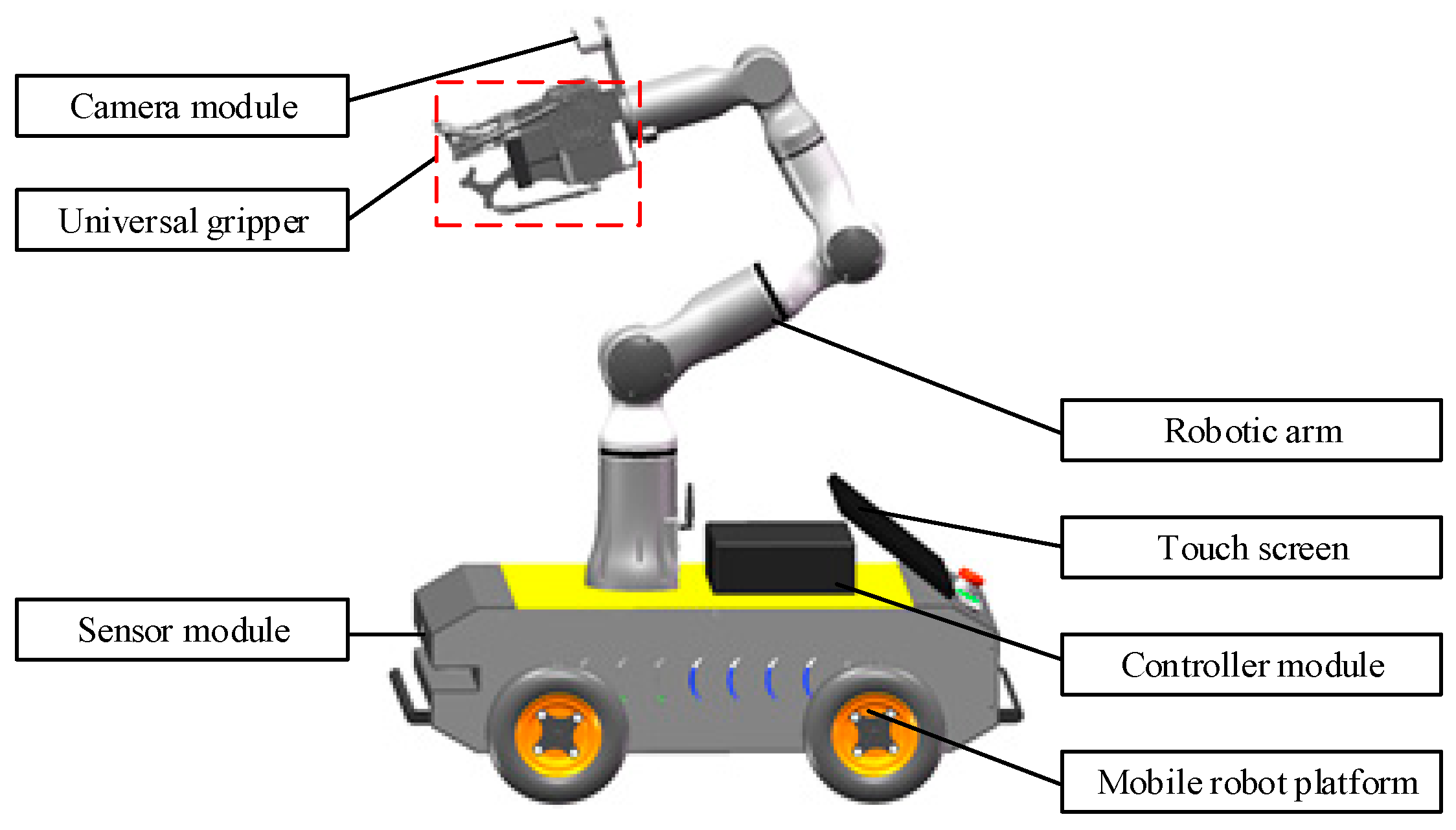
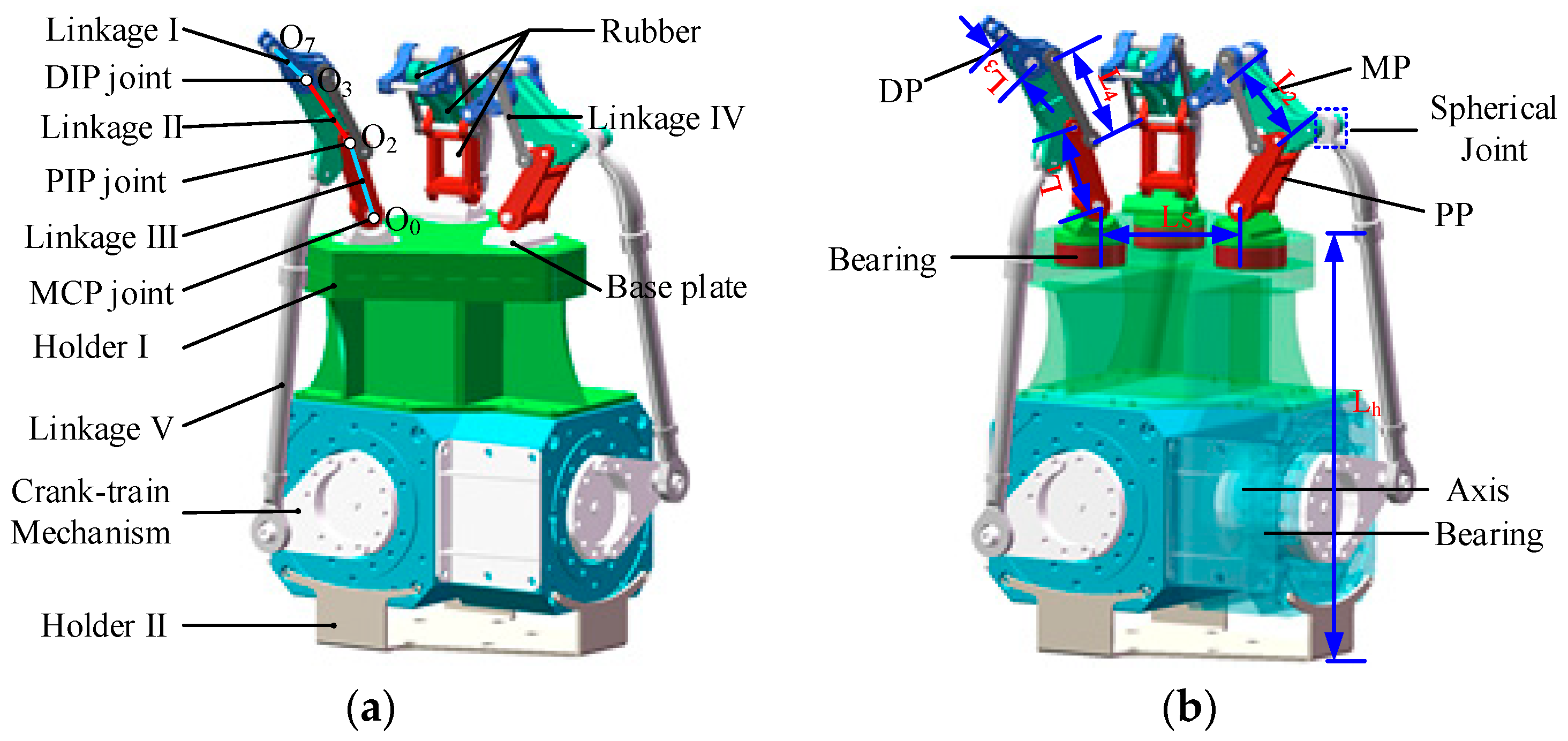
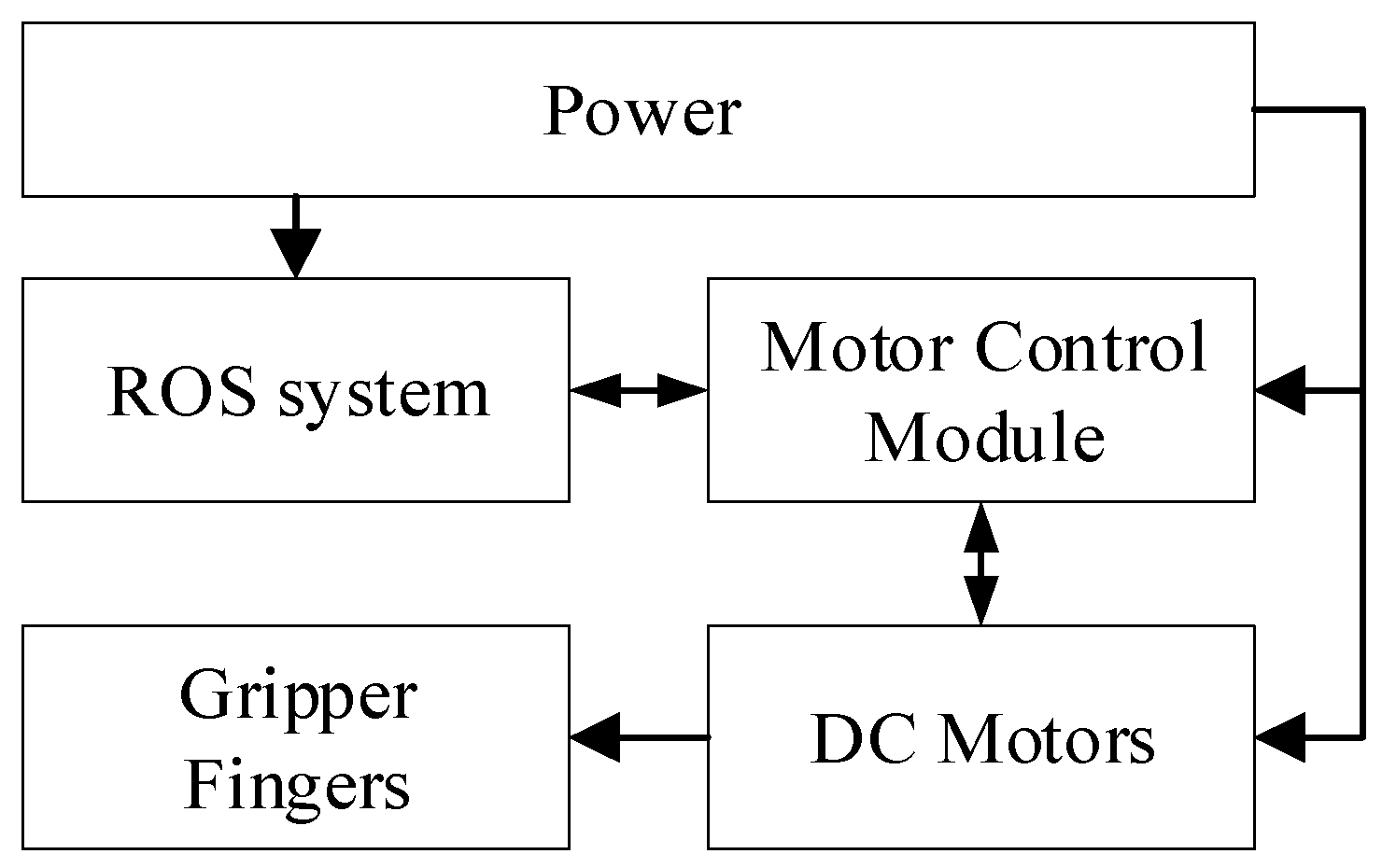
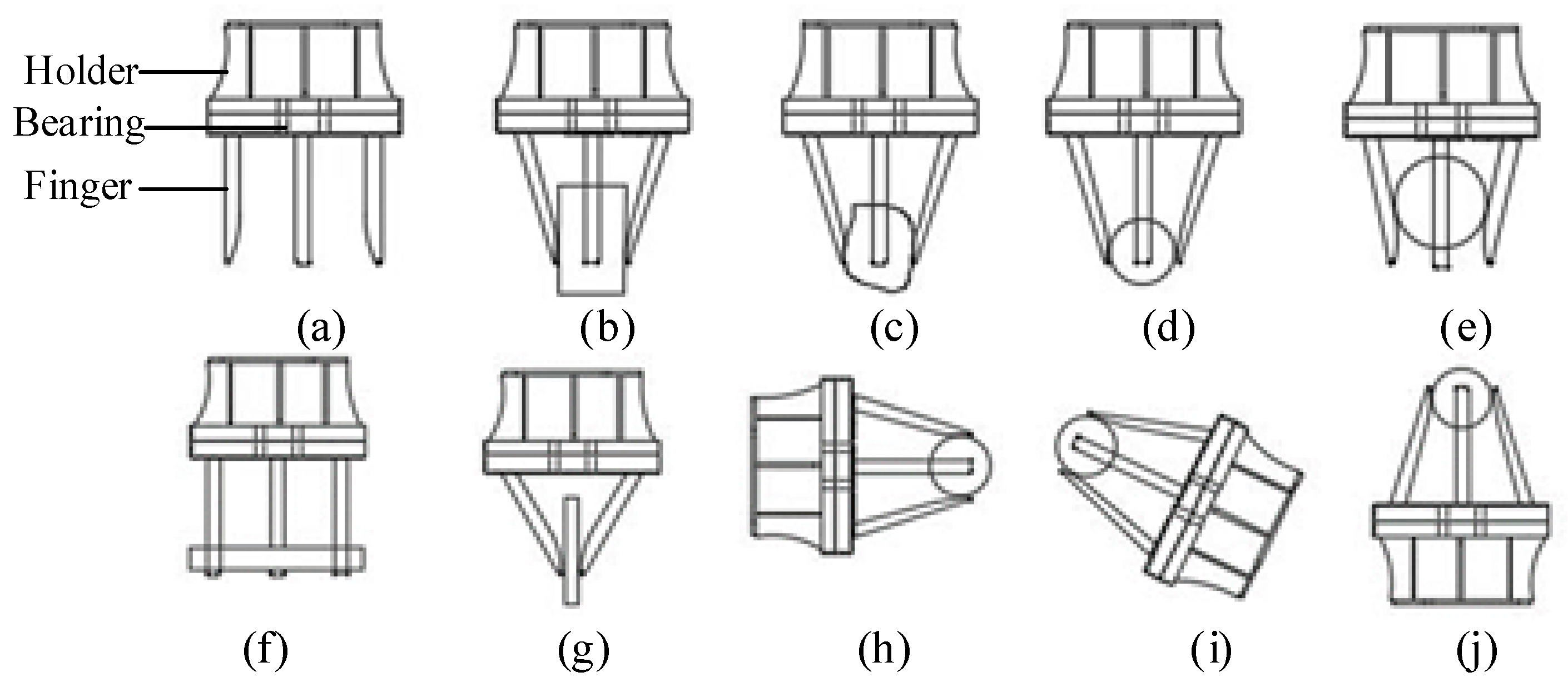

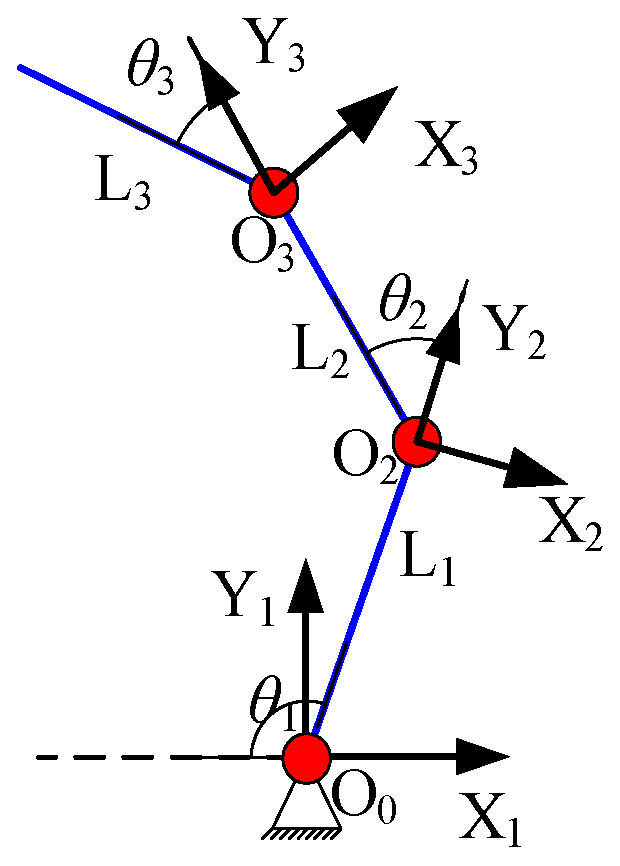

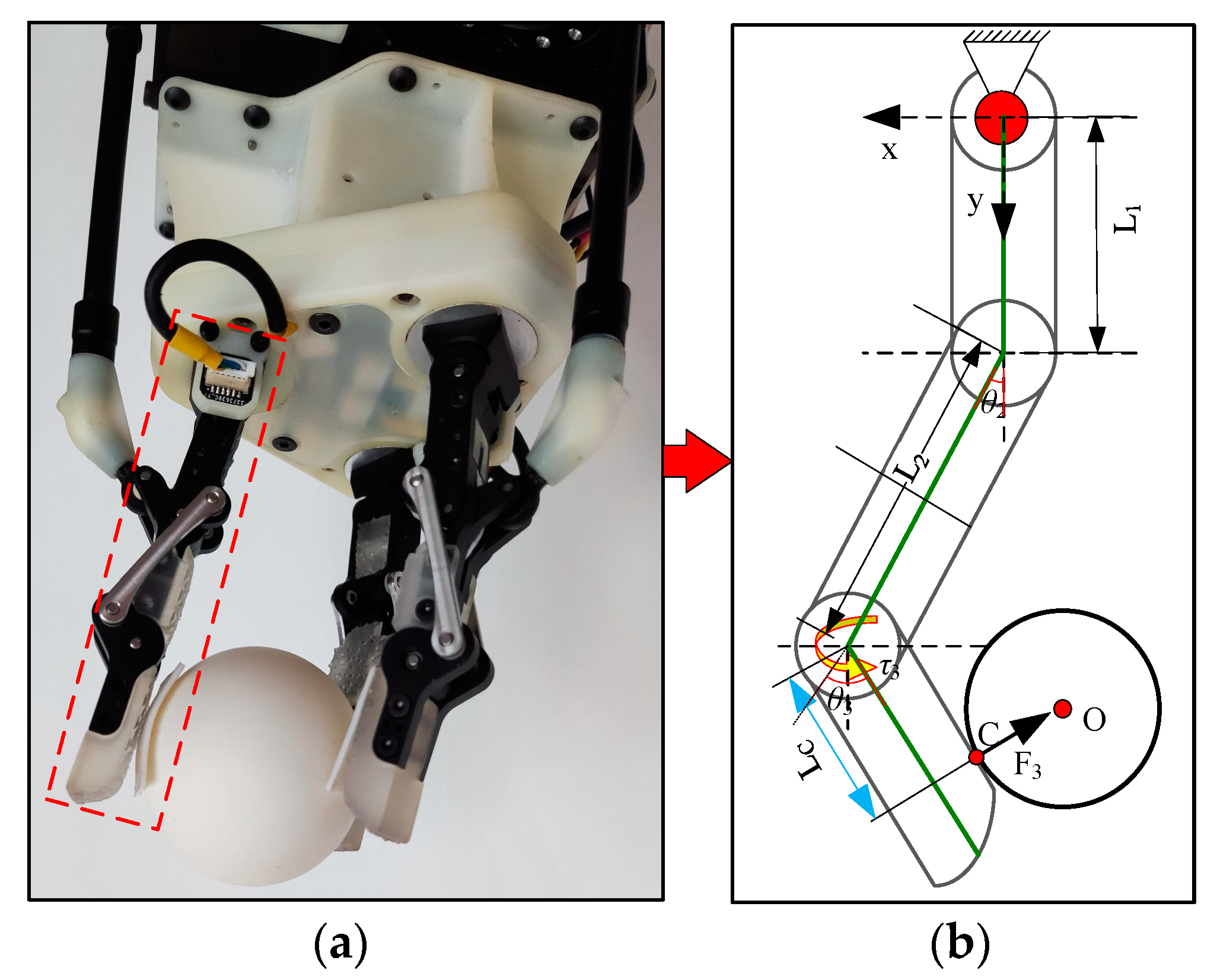
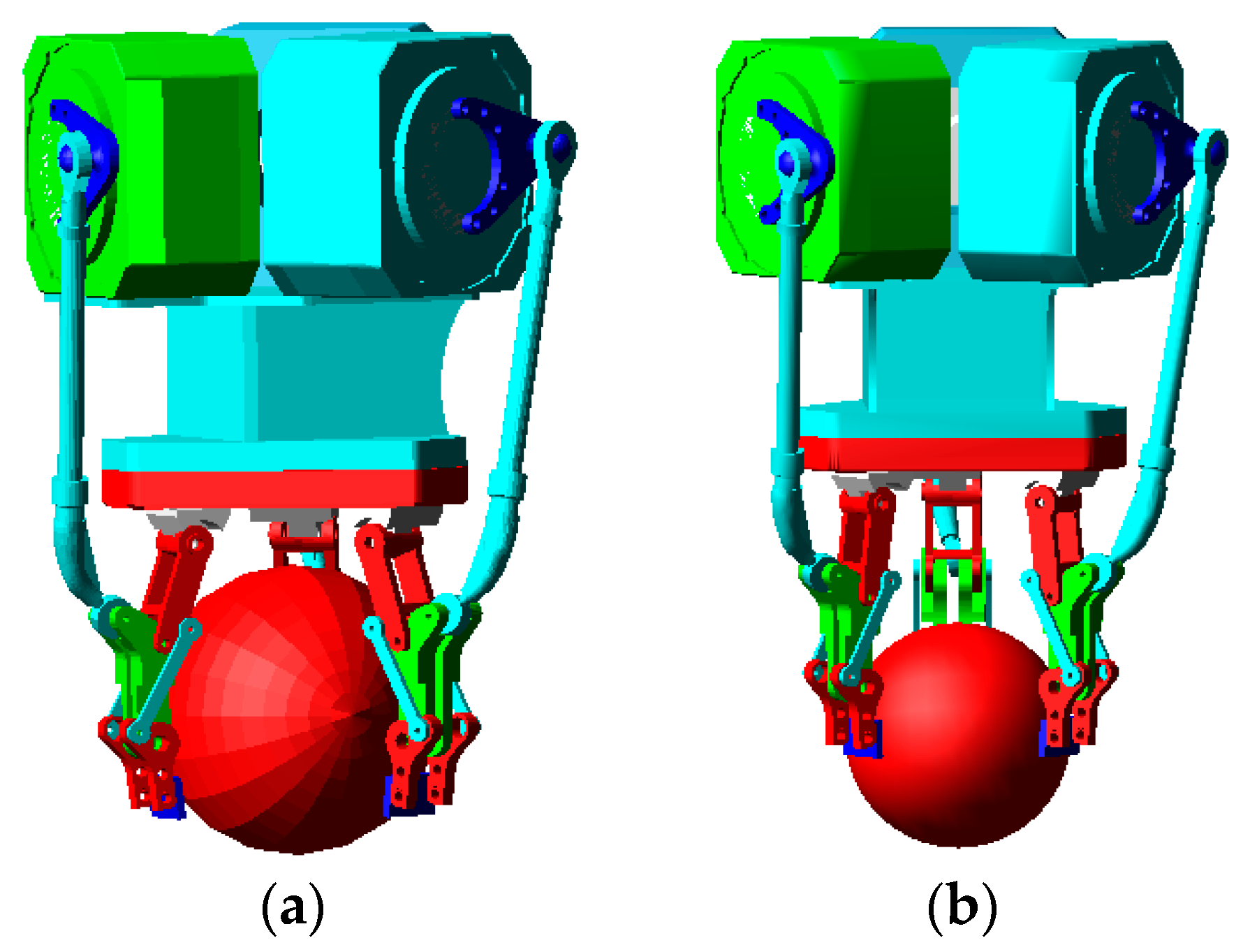
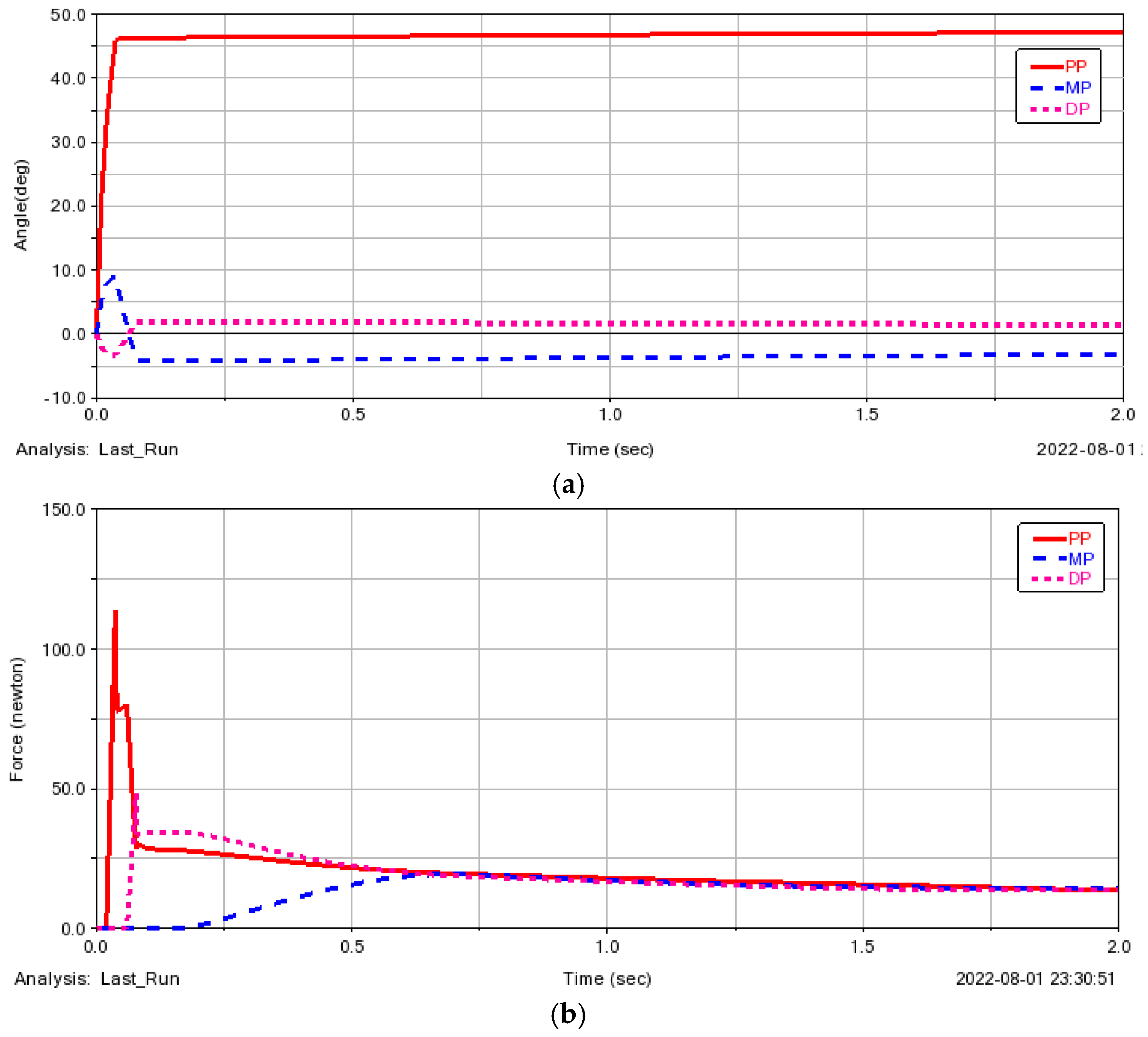
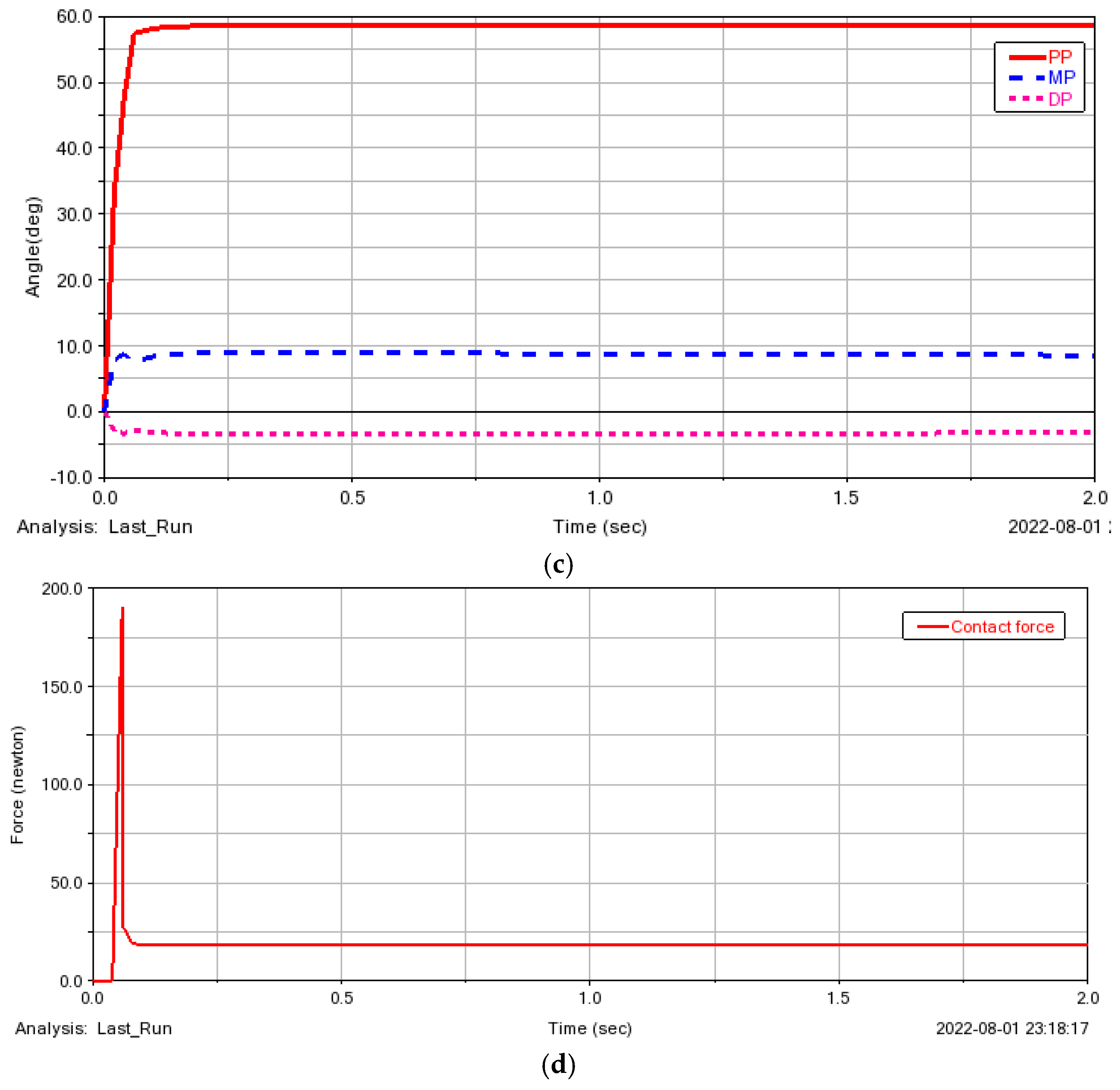

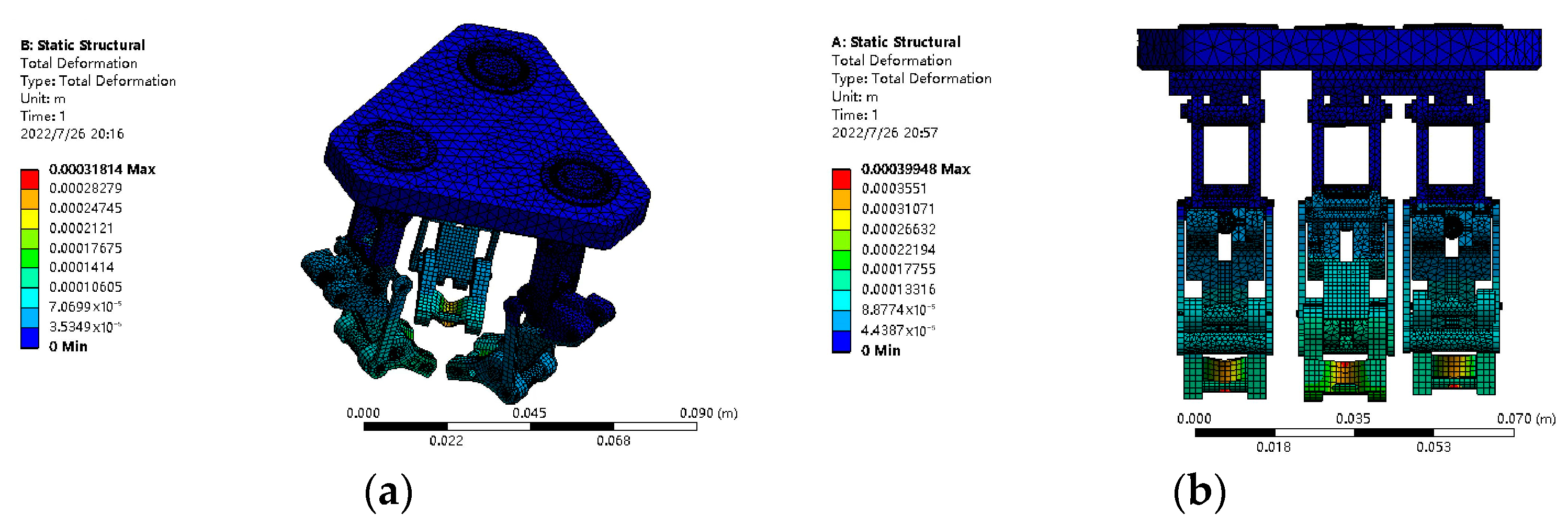
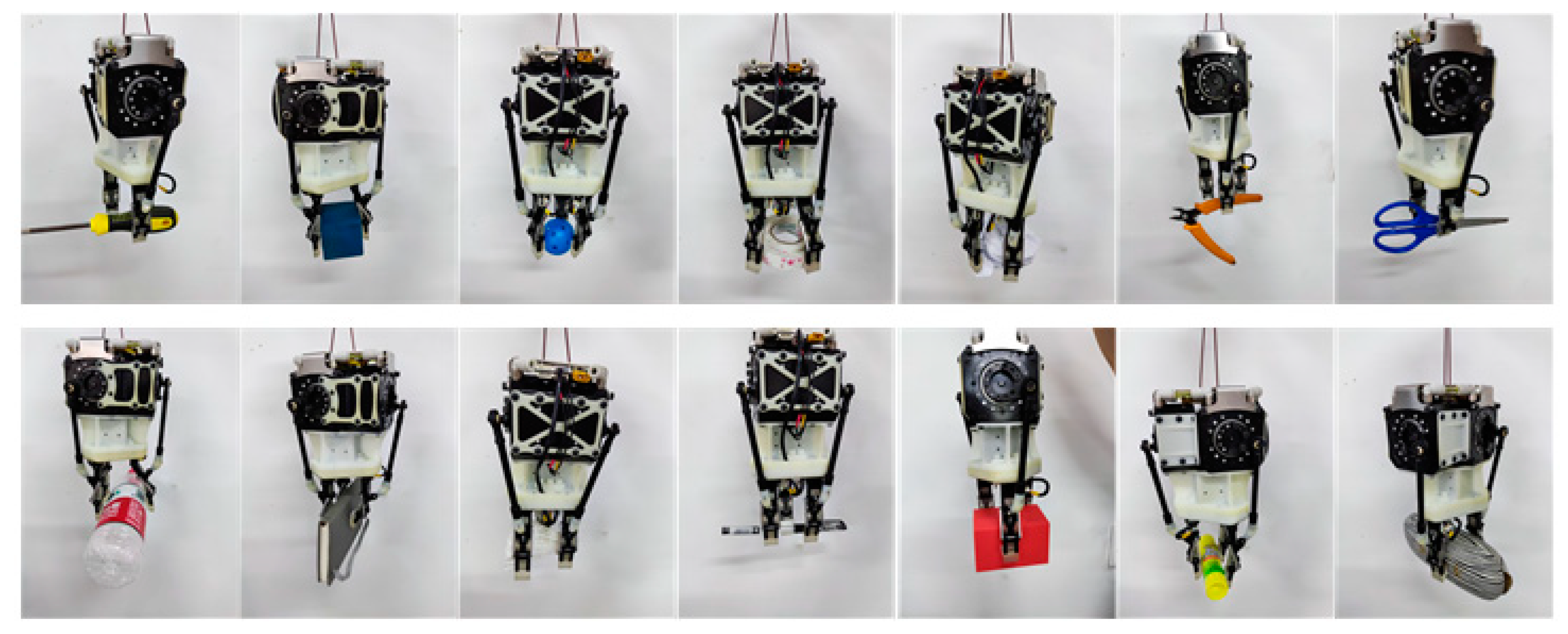
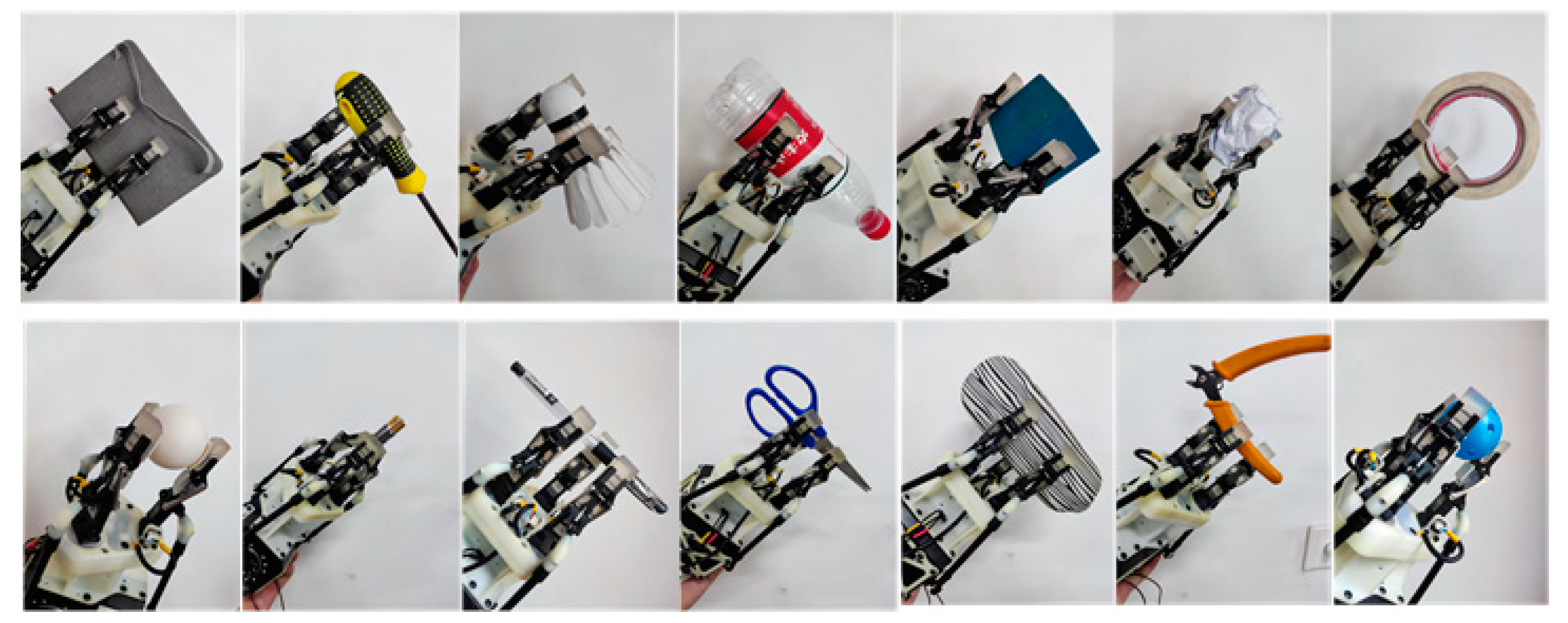
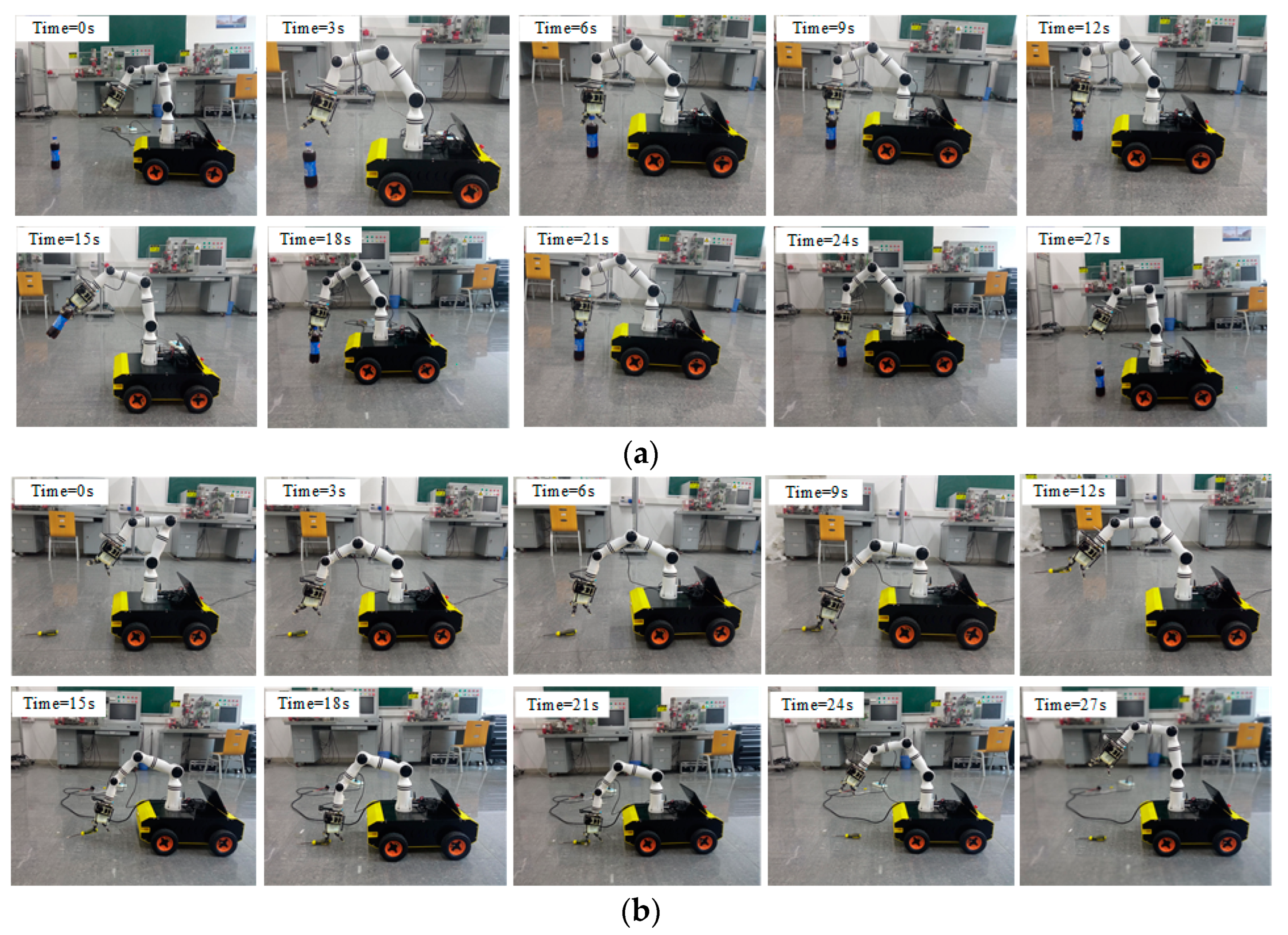
| Structural Design Category | Advantages | Disadvantages |
|---|---|---|
| Mechanical hinge [30] | High transmission efficiency, high joint stiffness and stable output force. | 1. Structure: redundancy, jumbled, bulky, inflexible, weak impact resistance; 2. High requirements for internal space configuration |
| Tendon, rope drive [31,32] | Lightweight, flexible and applicable | 1. Joint stiffness is affected by the deformation of tendon and rope. 2. The friction interference between tendon and finger structure is large. 3. The transmission efficiency is low. 4. The service life is low. |
| Soft grippers [33,34,35] | High structural flexibility, interaction safety, low cost, anti-interference. | 1. Low structural stiffness. 2. Difficult modeling. 3. Low control accuracy. |
| Rigid-flexible hybrid [36,37,38] | Complaisance and reliable. | Difficulty in fusion design. |
| Special configurations [39,40,41] | Multi-functional, low cost. | Poor universality. |
| Bionic joint [42,43] | Highly humanoid, compliant, impact resistant and controllable. | 1. The cost is high. 2. The system is complex. 3. The drive requirements are high. |
| Parameter Name | Parameter Value | |
|---|---|---|
| Camera (Intel realSense D435i) | Size | 90 mm × 25 mm × 25 mm |
| Precision | <2% | |
| Measurement distance range | 0.11–10 m | |
| Depth resolution ratio | 1280 × 720 | |
| Robotic arm (RM65-B) | Effective load | 5 kg |
| Re-orientation accuracy | ±0.05 mm | |
| power voltage | DC24 V | |
| communication methods | WIFI; USB; RS485 | |
| Mobile robot | Overall dimensions | 600 mm × 340 mm × 160 mm |
| Load | 15 kg | |
| Driving motors | GB37-520 | |
| Voltage | DC24 V | |
| Motors (Koala BEAR Beta) | Weight | 250 g |
| Speed constant | 27.3 RPM/V | |
| Torque constant | 0.35 Nm/A | |
| Gear ratio | 9 |
| Parameters | Symbol | Values (mm) |
|---|---|---|
| Total length of finger | L | 80 |
| Distal phalanx length | L1 | 27 |
| Middle phalanx length | L2 | 26 |
| Proximal phalanx length | L3 | 27 |
| Linkage IV | L4 | 115 |
| Finger distance | Ls | 50 |
| Total length of holder | Lh | 147 |
| Overall size | L × W × H | 115 × 97 × 227 |
| Phalanx i | θi | αi | Li | di | Range of θi (°) |
|---|---|---|---|---|---|
| 1 | θ1 | 0 | L1 | 0 | 90–135 |
| 2 | θ2 | 0 | L2 | 0 | 0–90 |
| 3 | θ3 | 0 | L3 | 0 | 0–85 |
Publisher’s Note: MDPI stays neutral with regard to jurisdictional claims in published maps and institutional affiliations. |
© 2022 by the authors. Licensee MDPI, Basel, Switzerland. This article is an open access article distributed under the terms and conditions of the Creative Commons Attribution (CC BY) license (https://creativecommons.org/licenses/by/4.0/).
Share and Cite
Wang, C.; Zhou, Y.; Xie, B.; Xie, J.; Zhang, J. An Underactuated Universal Gripper: Design, Analysis, and Experiment. Energies 2022, 15, 9151. https://doi.org/10.3390/en15239151
Wang C, Zhou Y, Xie B, Xie J, Zhang J. An Underactuated Universal Gripper: Design, Analysis, and Experiment. Energies. 2022; 15(23):9151. https://doi.org/10.3390/en15239151
Chicago/Turabian StyleWang, Chunguang, Yulin Zhou, Bing Xie, Jiuming Xie, and Junsheng Zhang. 2022. "An Underactuated Universal Gripper: Design, Analysis, and Experiment" Energies 15, no. 23: 9151. https://doi.org/10.3390/en15239151
APA StyleWang, C., Zhou, Y., Xie, B., Xie, J., & Zhang, J. (2022). An Underactuated Universal Gripper: Design, Analysis, and Experiment. Energies, 15(23), 9151. https://doi.org/10.3390/en15239151







